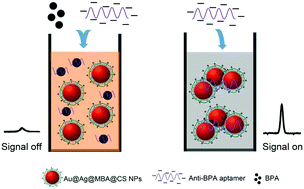A highly sensitive SERS probe for bisphenol A detection based on functionalized Au@Ag nanoparticles†
Abstract
Bisphenol A (BPA) usually exists in daily plastic products and its harmful effect on human health has been a popular topic. However, many conventional analytical methods need long sample preparation and measurement time, and some BPA biosensors suffer from the limitation of complex probe modification. Herein, we designed a simple SERS-coded aptamer sensor for BPA detection based on the electrostatic interaction between chitosan encapsulated 4-MBA coated Au@Ag NPs and anti-BPA aptamers. The negatively charged nucleic acid anti-BPA aptamer will cause the aggregation of the positively charged noble metal nano-reinforced substrate in acid buffer systems, resulting in a significant enhancement of the Raman signal. The specific binding of BPA with nucleic acid anti-BPA aptamers reduced the degree of aggregation of nanoparticles and weakened the SERS signal. This SERS-coded aptamer sensor had a wide linear range of 0.01–1 ng mL−1 and the limit of detection (LOD) was as low as 2.8 pg mL−1, and the method was successfully applied to detect BPA in bottled water within 15 min. As a rapid, simple, ultrasensitive and highly selective analytical technique for the detection of BPA, this SERS-based method would be important in biomedical diagnostics, environmental monitoring and food safety.



 Please wait while we load your content...
Please wait while we load your content...